This is a set of instructions on how to integrate with Marketo. This is to create a webhook within your Marketo environment to get the benefits of ZeroBounce email validation in real-time.
Getting started with Marketo For more documentation about Marketo please take a look at their docs. https://docs.marketo.com to find more details about marketo
CUSTOM FIELDS SETUP
- Step 1:Go to your Marketo My Dashboard.
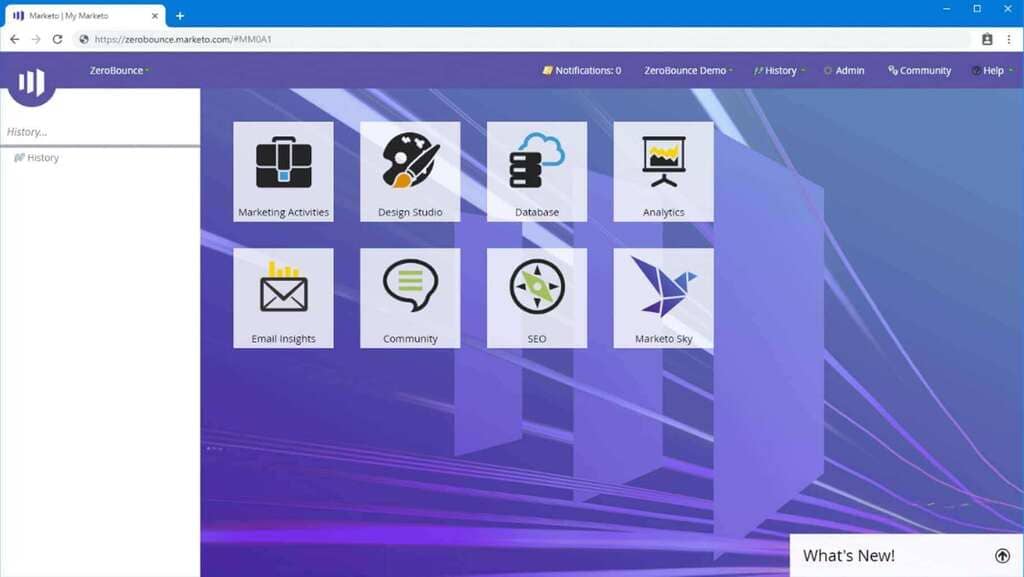
Marketo Dashboard
- Step 2:Click on Admin on the top menu and click on Database Management ➔ Field Management
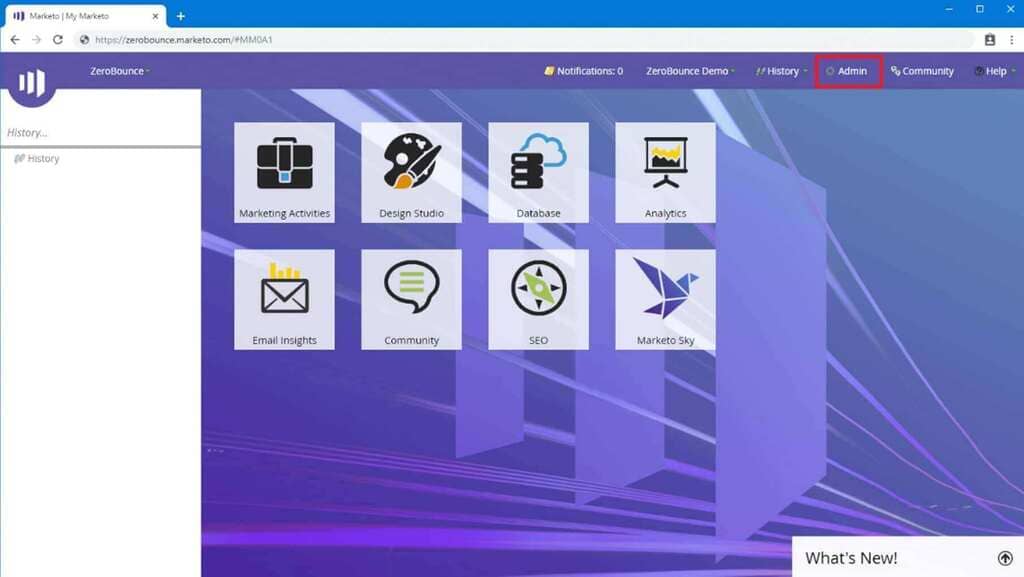
Click the admin button on the top right.
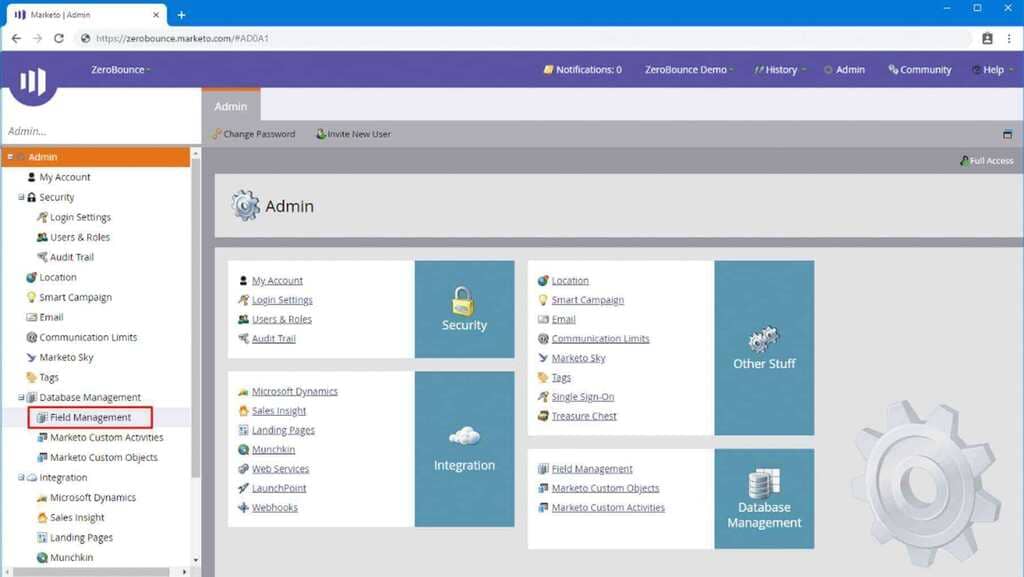
Click on field management
- Step 3:Create a New Custom Field.
You will need to create custom fields in Marketo to match the API results from the ZeroBounce API.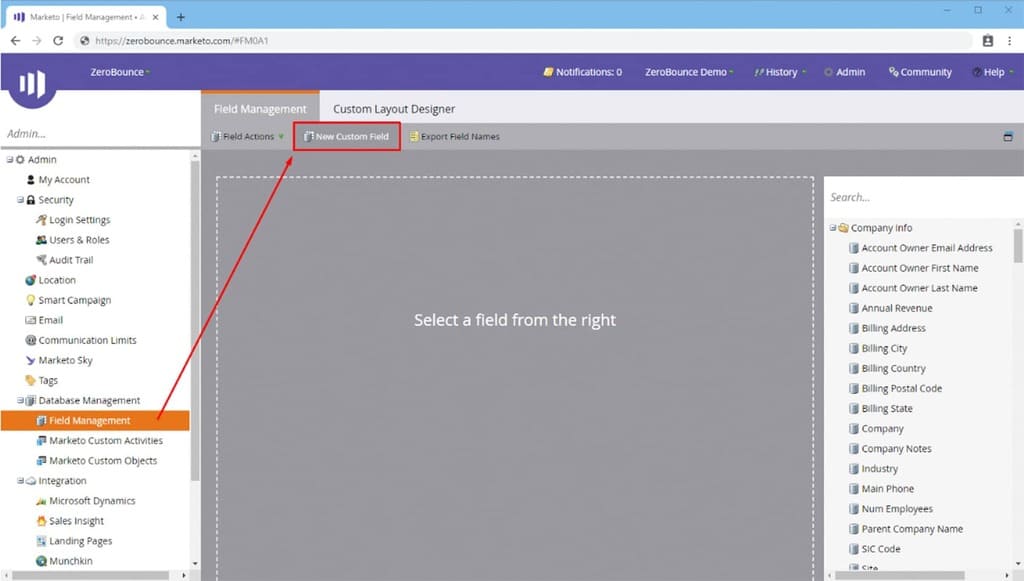
Click on new custom field
- Step 4:Fill in the popup form with the appropriate data type in reference to each property found on the ZeroBounce API result.
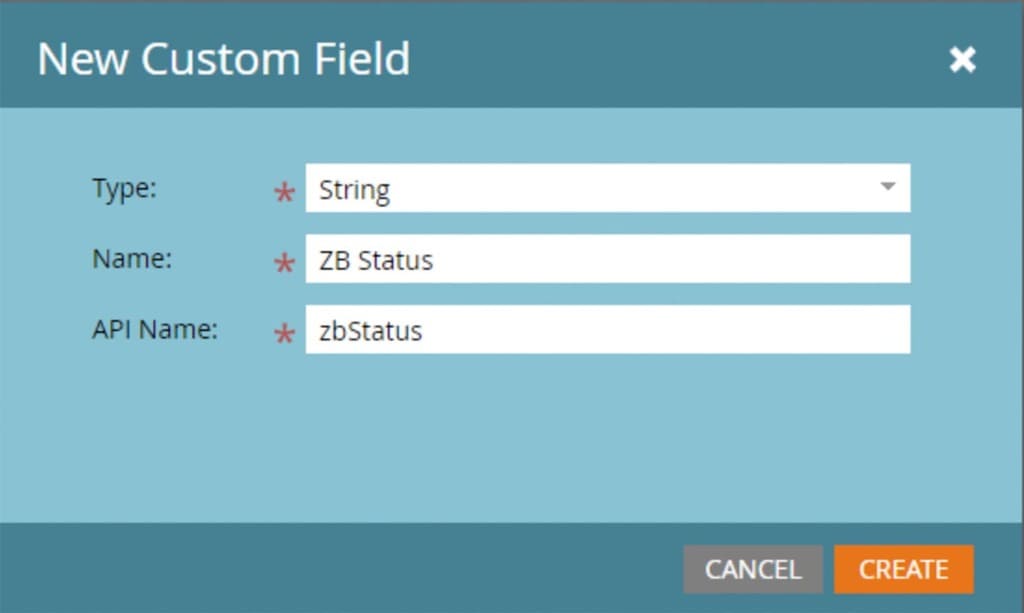
Fill out new custom field with appropriate values
- Step 5:Ensure that all of the properties are created by searching for “ZB” in the Fields Management Fields search bar on the right pane.
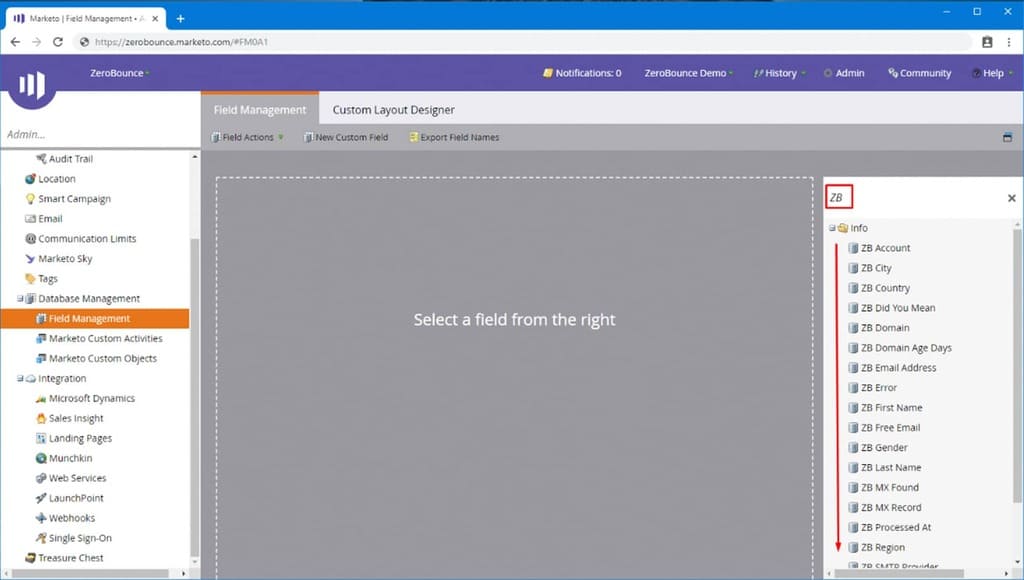
Verify that the correct fields have been created on the right
LIST SETUP
- Step 1:Go to the Marketo Database so we can create a new Group List or Group Smart List.
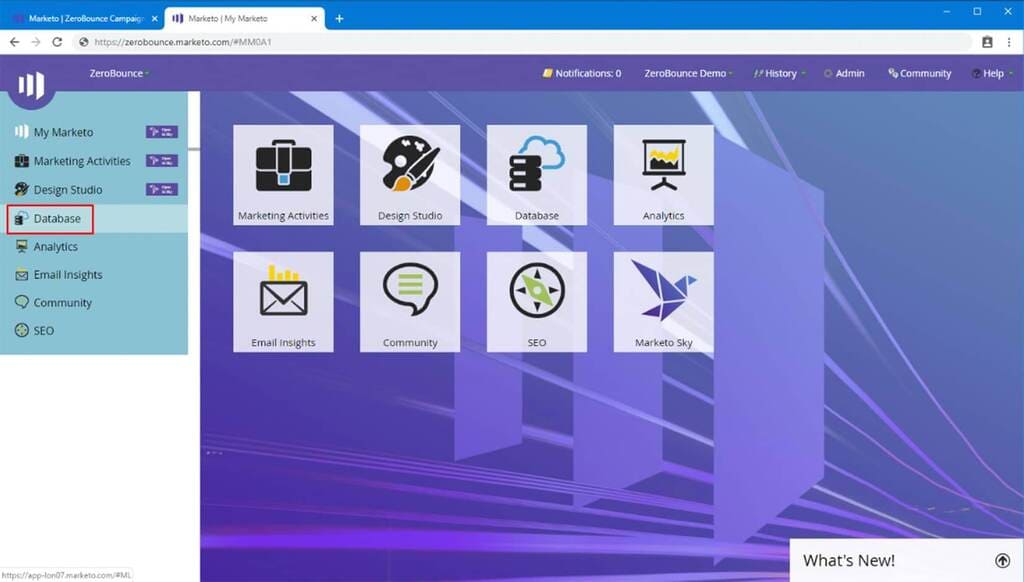
Click on Admin and on the left pane click on "webhooks". You should now see ZeroBounce in your list of available webhooks
- Step 2:Once we are on the Lead Database screen you can create a new Group folder by right-clicking Group Lists and choose New Folder
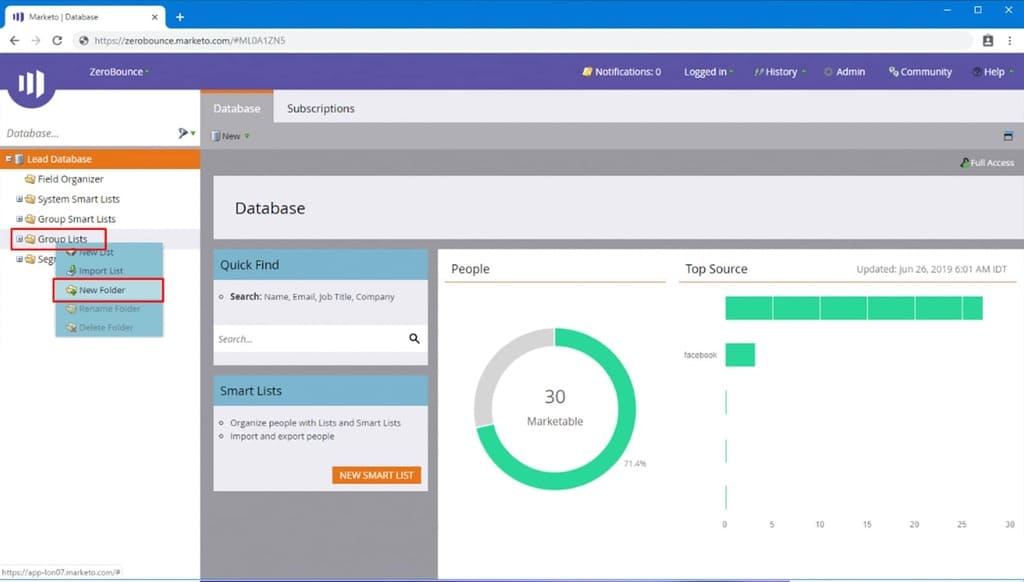
- Step 3:Create a new List by choosing New ➔ New List in the Database top menu.
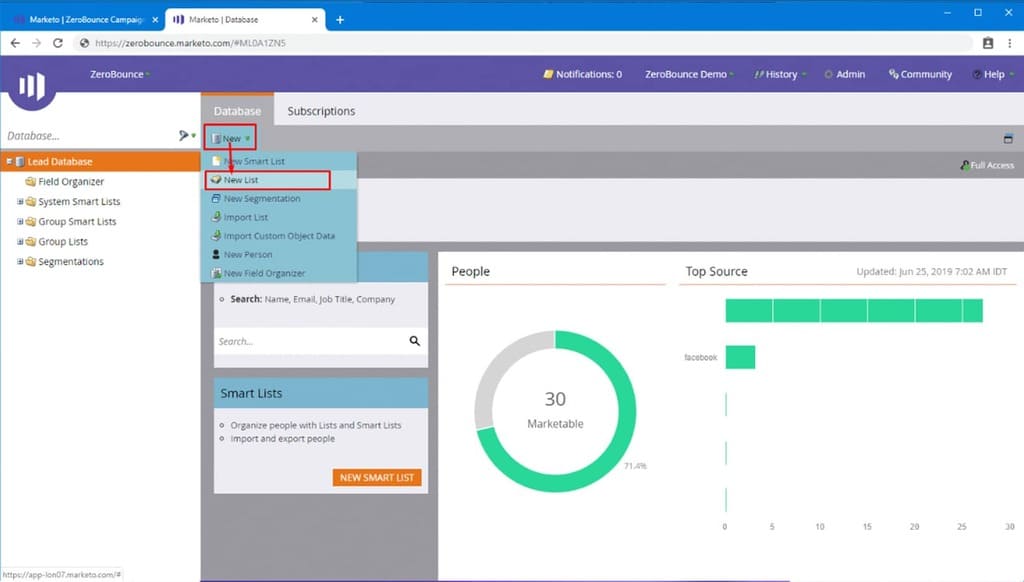
- Step 4:Fill in the New List form
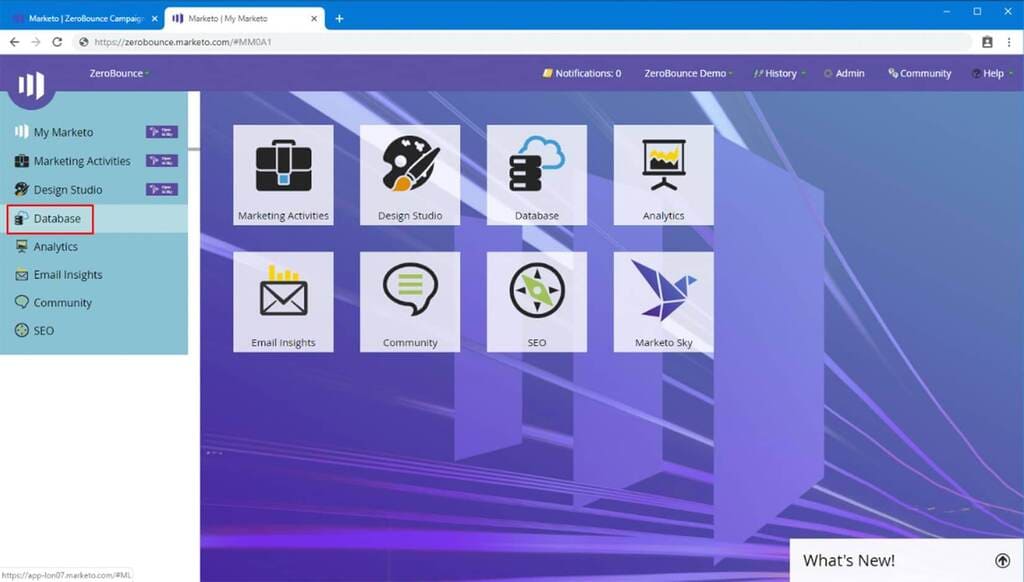
Create new list window
WEBHOOK SETUP
- Step 1:Once we have successfully created our list we can now start working on our ZeroBounce Webhook. We want to go to our Marketo Admin by clicking on Admin on the top menu and then clicking on Integration ➔ Webhooks on the left navigation menu.
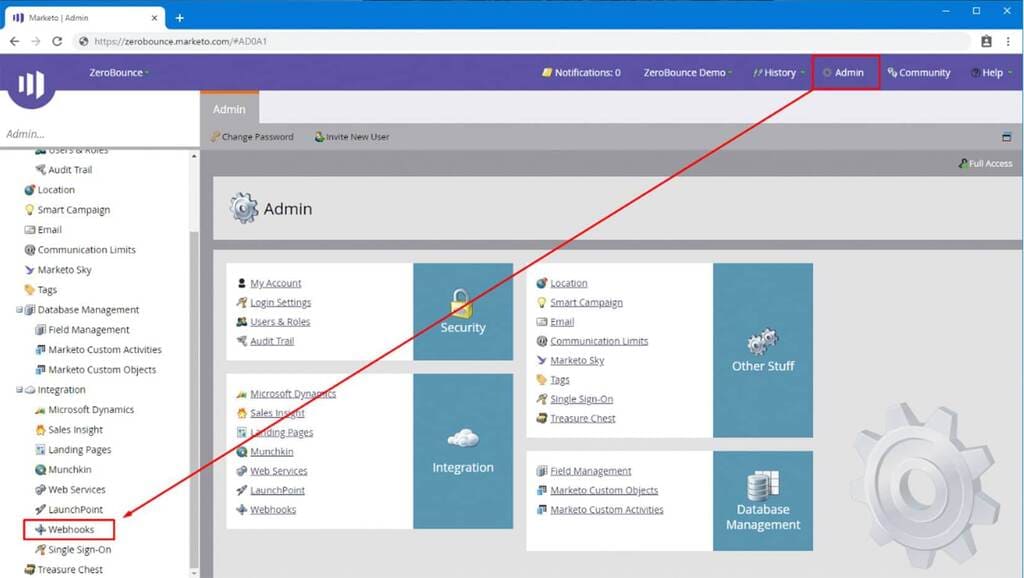
Click on the WebBooks link on the right side of your Marketo Dashboard
- Step 2:Click on Webhooks in the left navigation menu under the Integration section
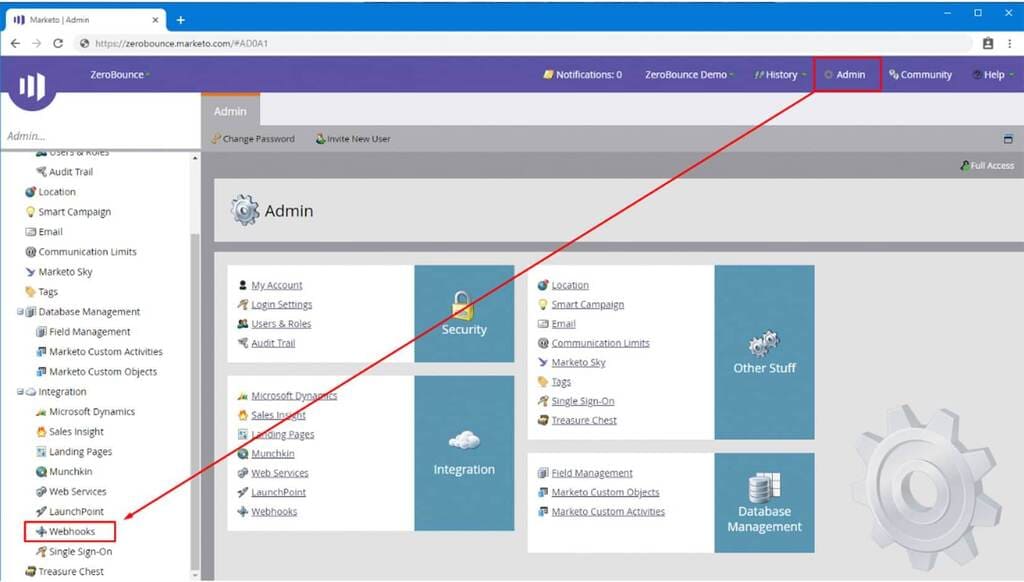
Select WebHooks on the left pane
- Step 3:WebHooks Screen: Click on the new WebHook button
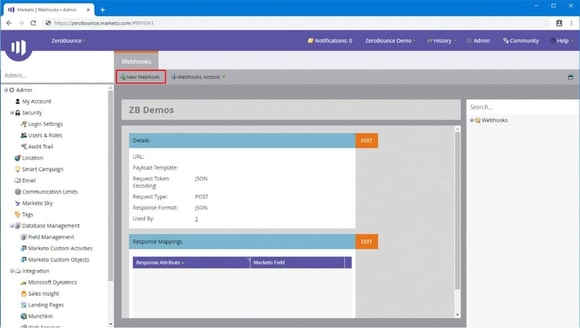
WebHooks Screen: Click "New WebHook
- Step 4:Fill out the form with the following information:
- Webhook Name: ZeroBounce
- Description: ZeroBounce Email Validation Webhook
- URL: You will need to generate a new API key in ZeroBounce. https://api.zerobounce.net/v2/validate?api_key=8a42b102c171439ca78e2140bf3f8cc9&email={{lead.Email Address}}&ip_address={{lead.Anonymous IP}}
- api_key - This comes from your ZeroBounce API (/members/apikey/)
- email - this information is filled by Marketo by using the “'{{lead.Email Address}}” token
- ip_address - this information is filled by Marketo by using the “{{lead.Anonymous IP}}” token
Once the form is filled out completely click the Create button.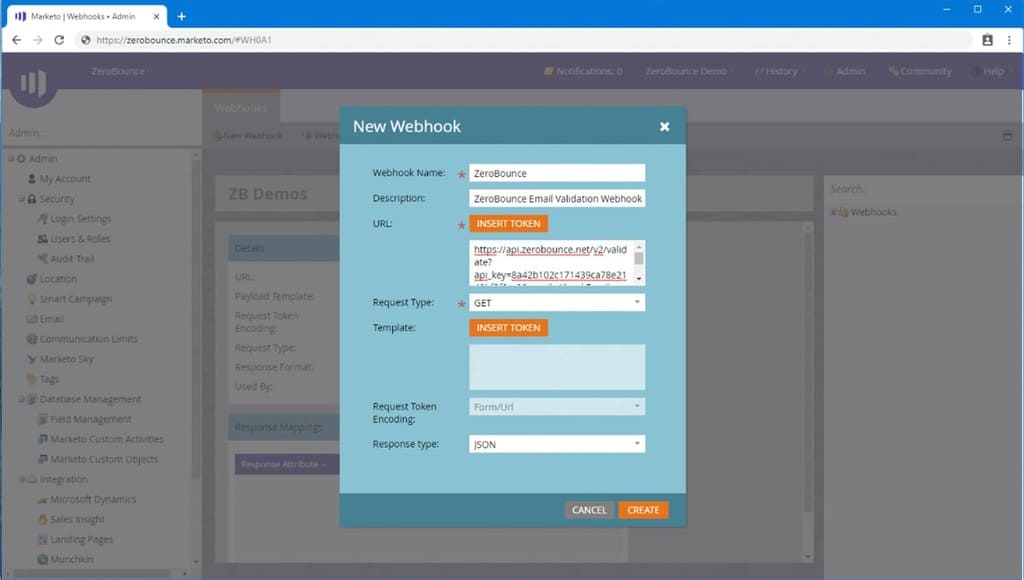
New WebHook Form
- Step 5:You should now see ZeroBounce in your list of available webhooks
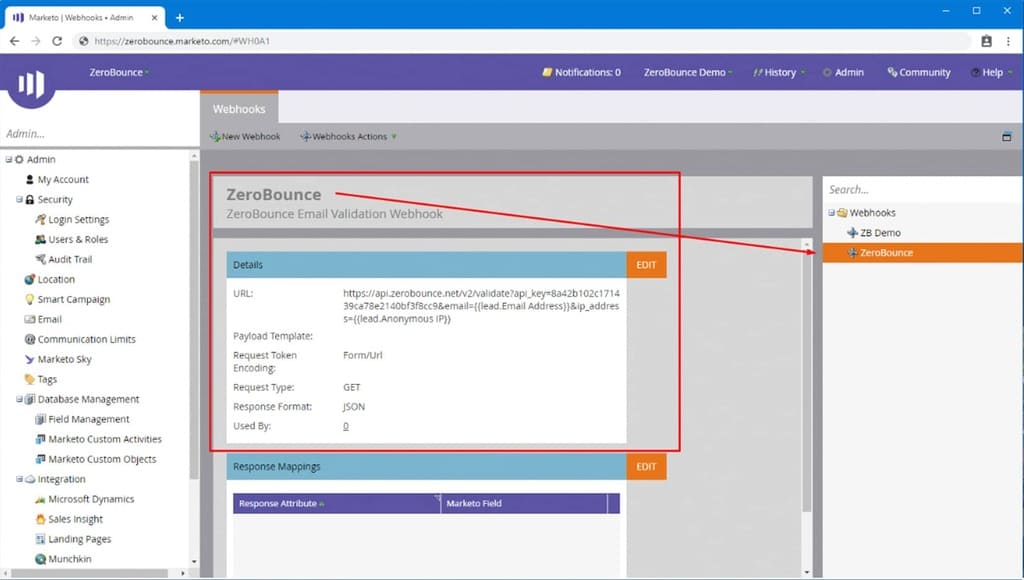
ZeroBounce WebHook in Marketo dashboard
- Step 6:
Now that we have our Webhook we still need a way to handle the ZeroBounce API results. We need to map those results from ZeroBounce API to Marketo fields that we created earlier.
In the Response Mappings section click Edit.
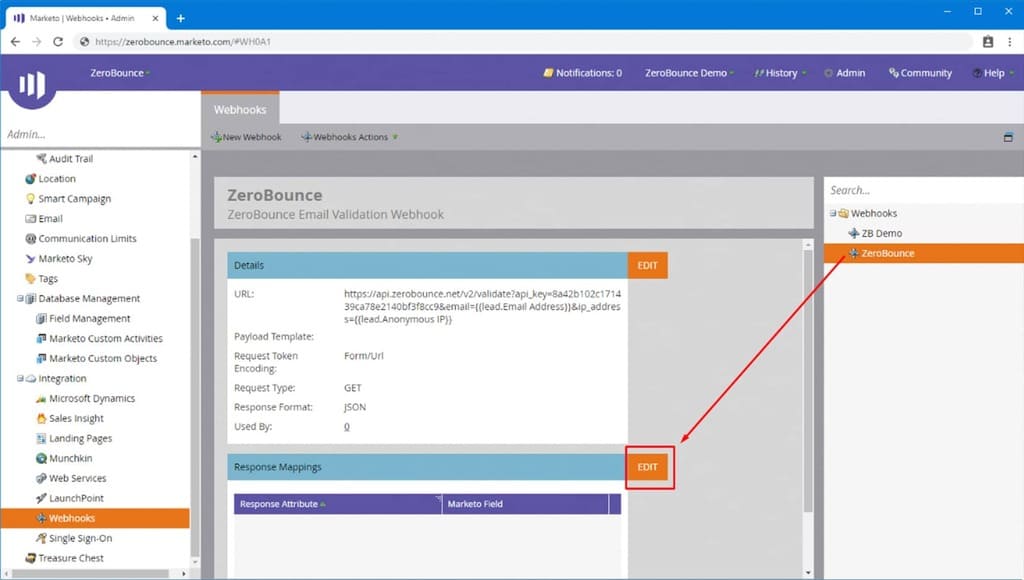
Edit the response mapping on your webhook
- Step 7:Click Add to add each property mapping from ZeroBounce API to Marketo custom fields.
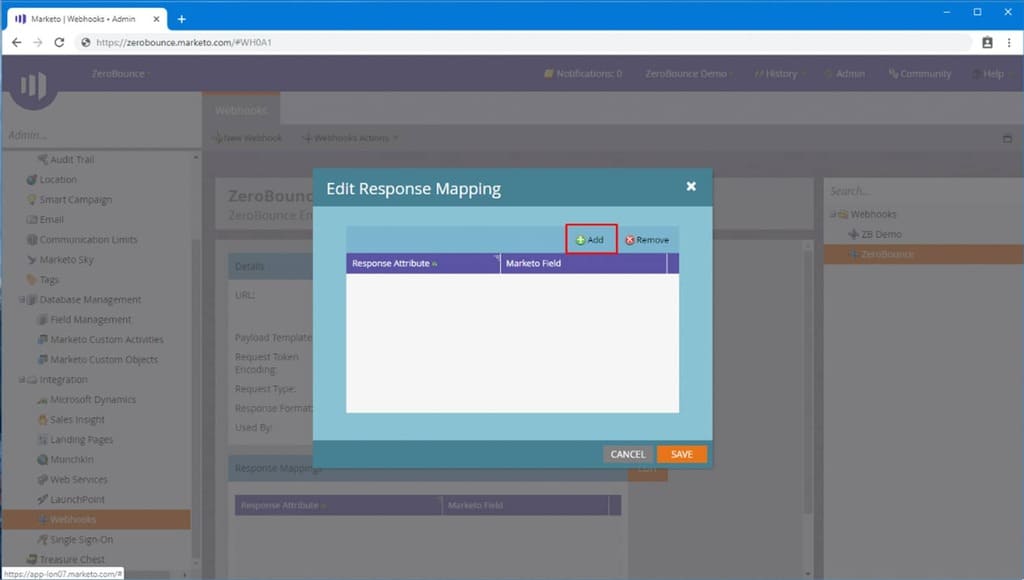
- Response AttributeMarketo Field
- accountzbAccount
- addresszbEmailAddress
- cityzbCity
- countryzbCountry
- did_you_meanzbDidYouMean
- domainzbDomain
- domain_age_dayszbDomainAgeDays
- errorzbError
- firstnamezbFirstName
- free_emailzbFreeEmail
- genderzbGender
- lastnamezbLastName
- mx_foundzbMxFound
- mx_recordzbMxRecord
- processed_atzbProcessedAt
- regionzbRegion
- smtp_providerzbSmtpProvider
- statuszbStatus
- sub_statuszbSubStatus
- zipcodezbZipCode
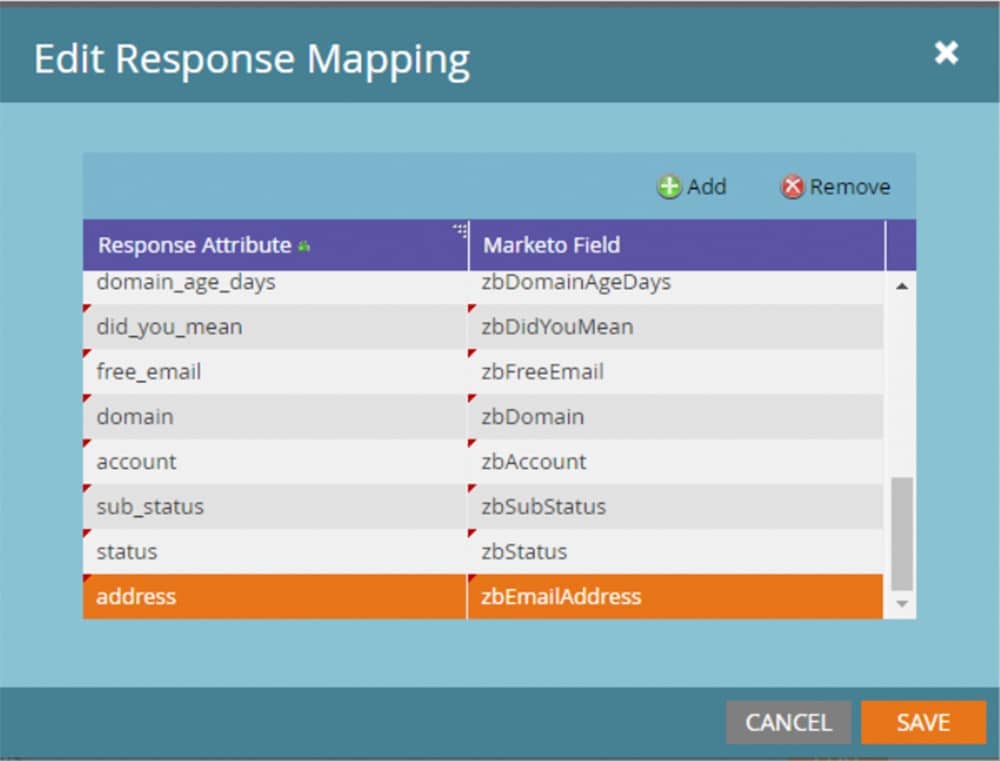
Response Mapping List
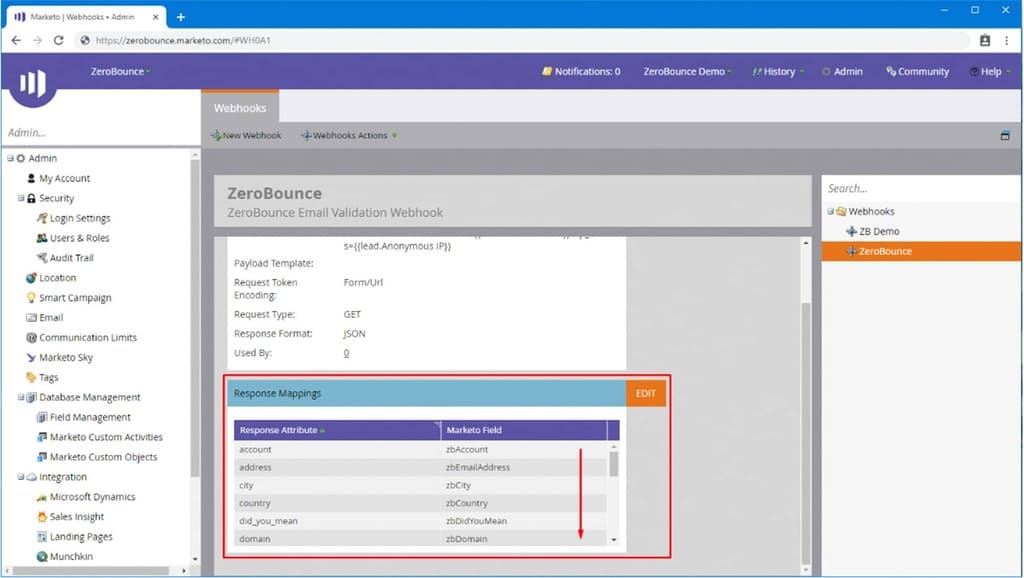
Completed response mapping screen
FORMS SETUP
- Step 1:Now that we have our mappings setup we can now create our forms. Go to your Marketo Design Studio.
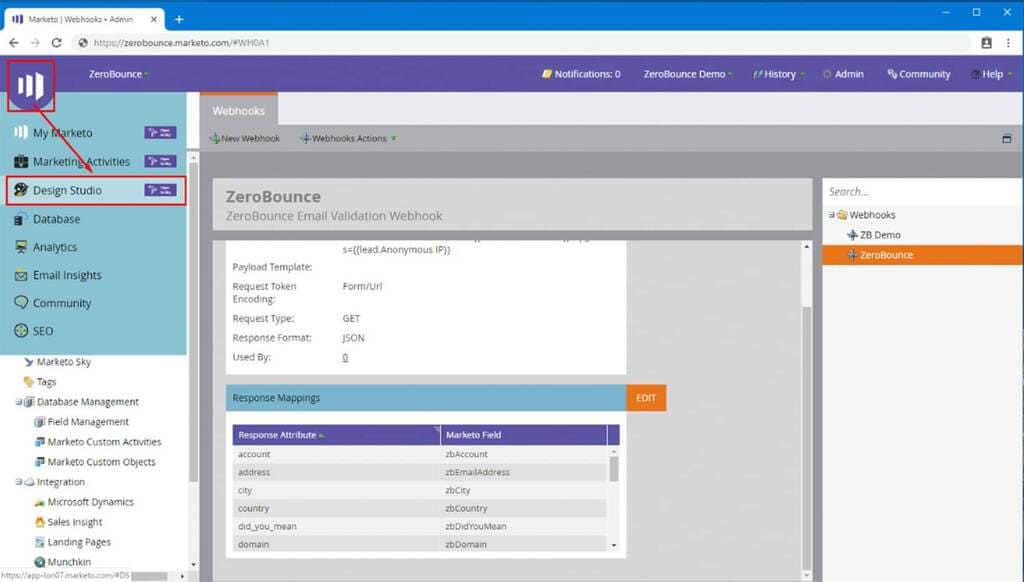
Marketo Dashboard: Click "Design Studio
- Step 2:Let’s create a new form. In the Design Studio click on New ➔ New Form.

Design Studio: Click on New and Choose New Form
- Step 3:Fill out the New Form popup and click Create.
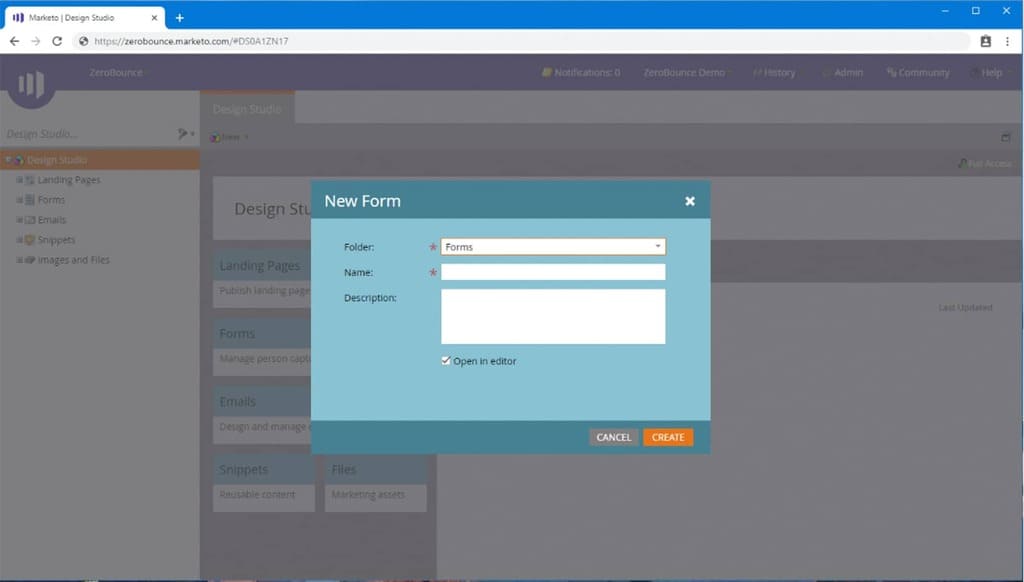
New Form window
- Step 4:We can stick to the default settings for the form. Click Finish. Then click Approve and Close.
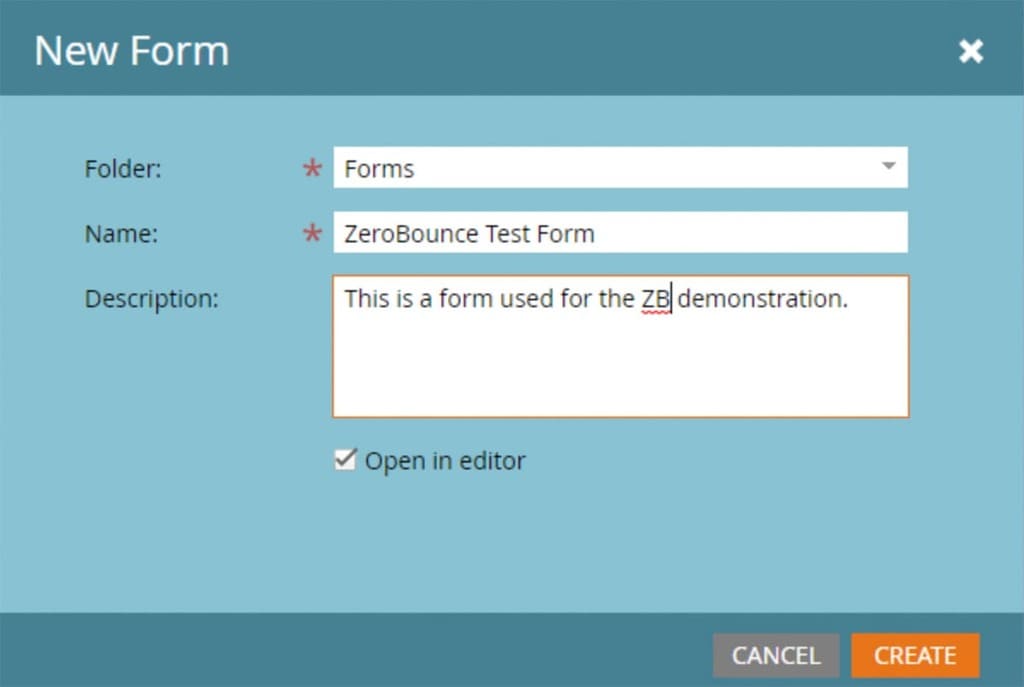
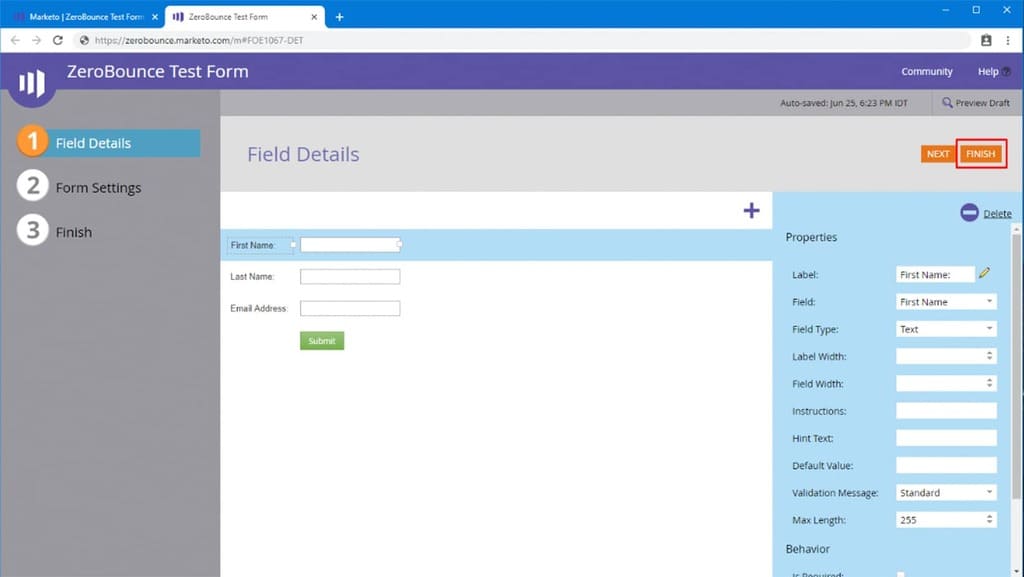
Click Finish once your are completed
LANDING PAGE SETUP
- Step 1:Let’s create our Landing Pages. Let’s create a Thank You page. Within the Design Studio click New ➔ New Landing Page.

Select Design Studio on the left pane
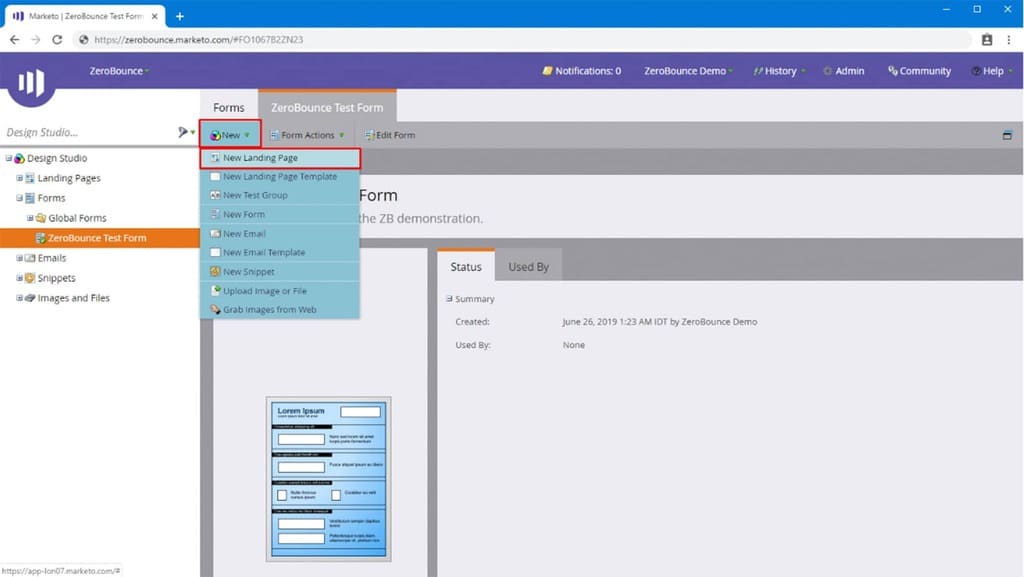
Select New Landing Page under the "new" dropdown
- Step 2:Fill in the New Landing Page popup form and click Create.
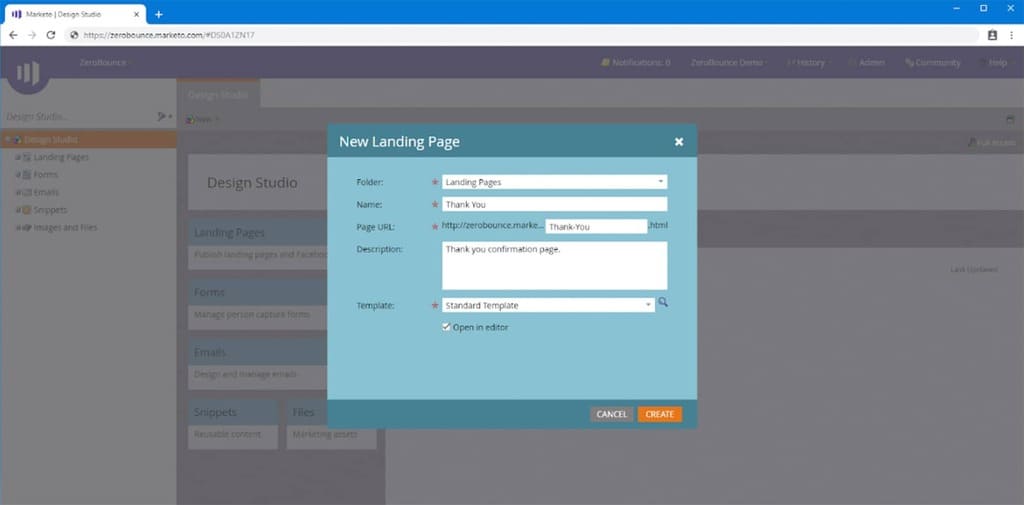
New landing page form window
- Step 3:In the editor click and drag the Rich Text box over to the page container and type in a Thank You message and save the design and ensure to click Approve and Close.
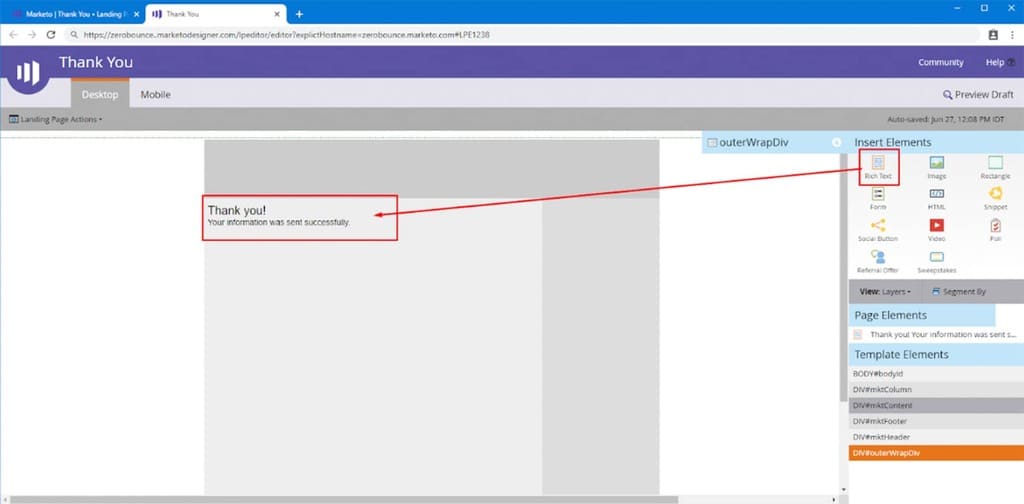
Landing page editor window
- Step 4:Let’s create one more Landing Page. From the Design Studio click New ➔ New Landing Page.
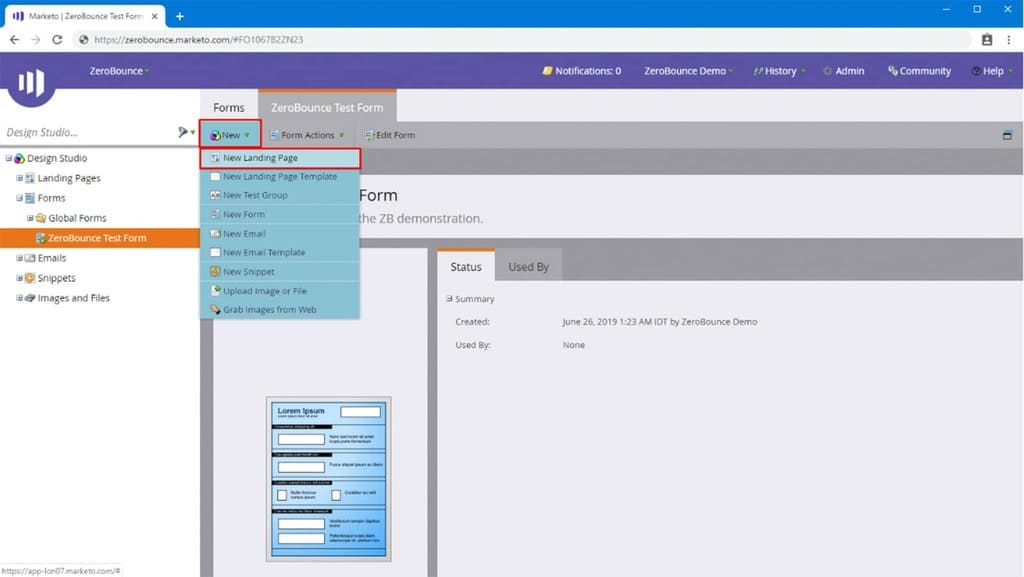
Create a new landing page
- Step 5:Fill in the New Landing Page popup form and click Create.
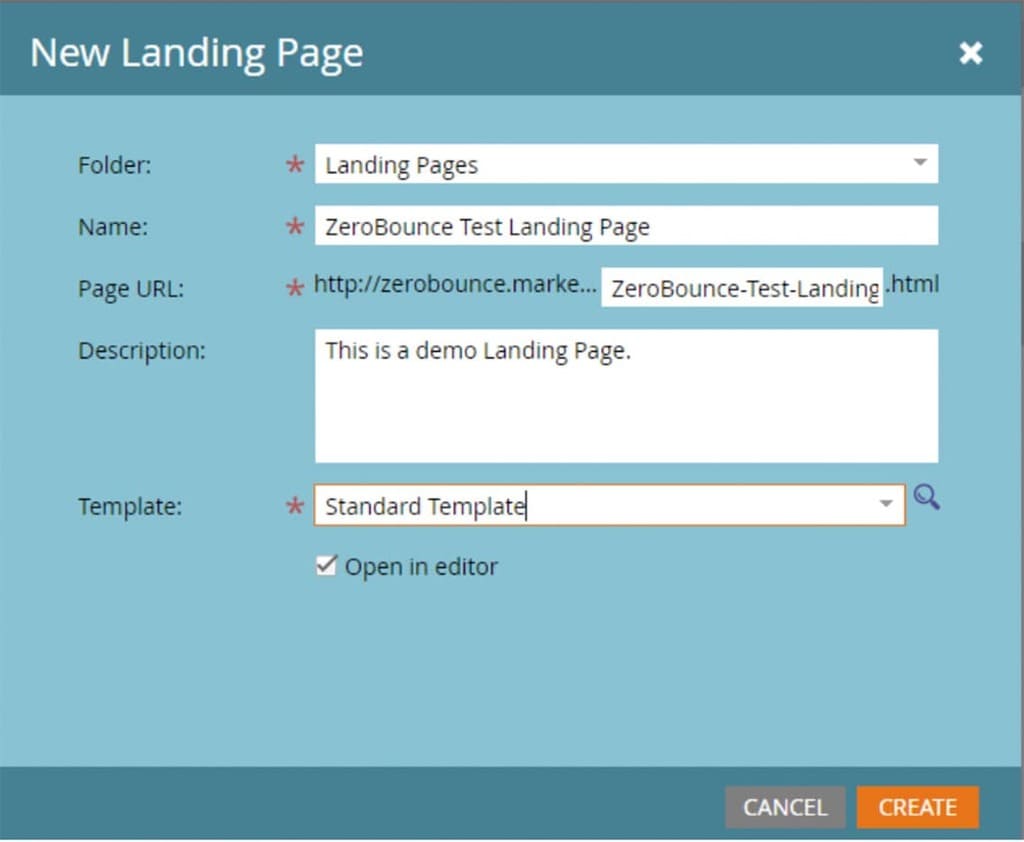
Fill out "New Landing Page" form
- Step 6:Click and drag the Form element to the editor container.
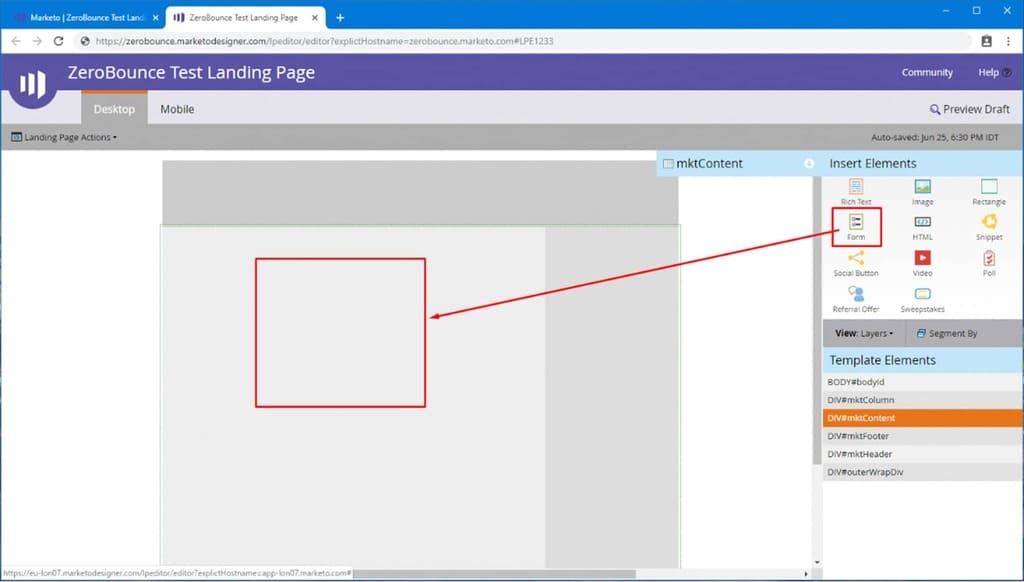
Drag the form element from right pane in "Design Studio"
- Step 7:Fill in the Insert New Form popup and choose the ZeroBouce Test Form we created earlier.
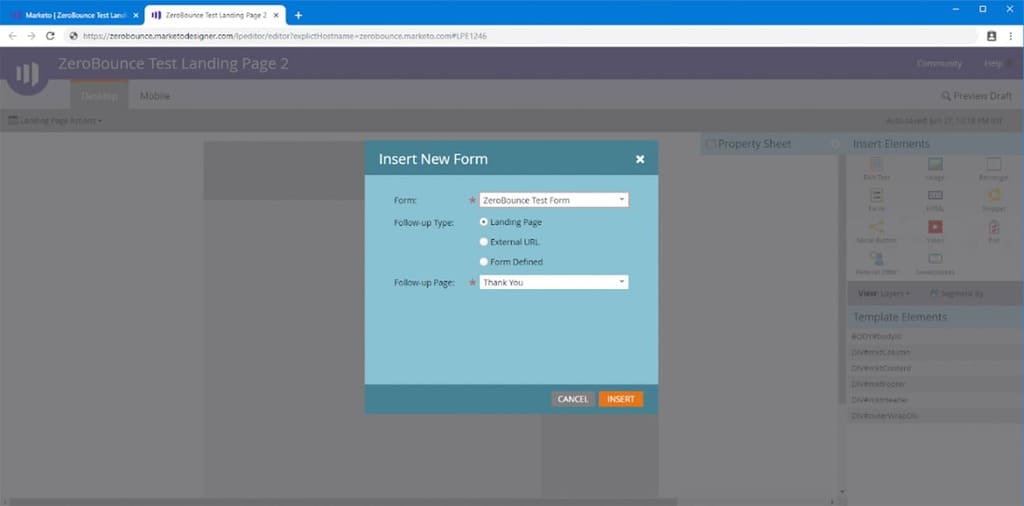
Select the previous Landing Page you created
- Step 8:Once we are finished setting up our Landing Page. Click the Landing Page Actions menu and choose Approve and Close.
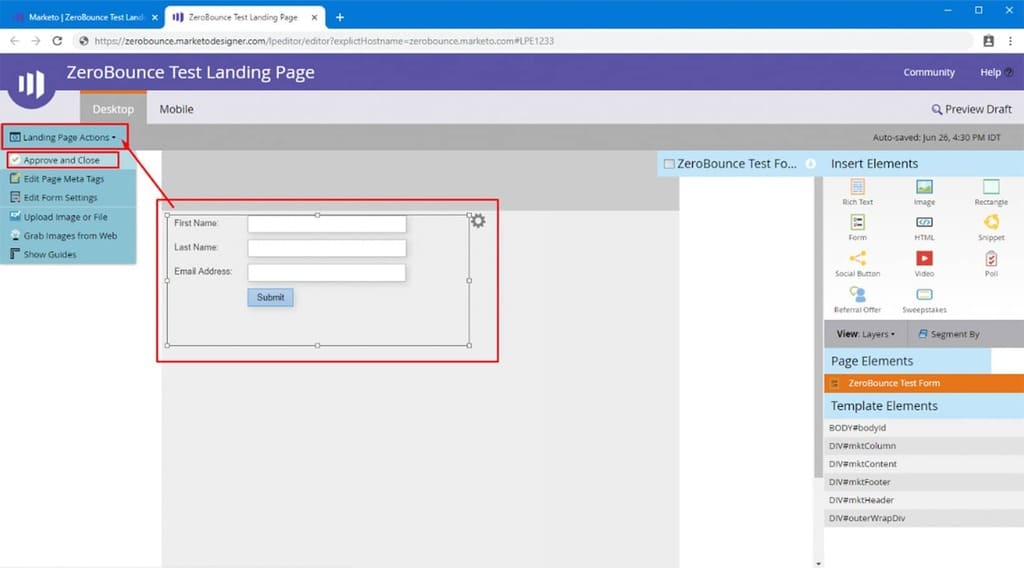
Select "Landing Page Actions" on the left pane
CAMPAIGN SETUP
- Step 1:Let’s setup a campaign. From the Marketo Logo menu click on Marketing Activities.
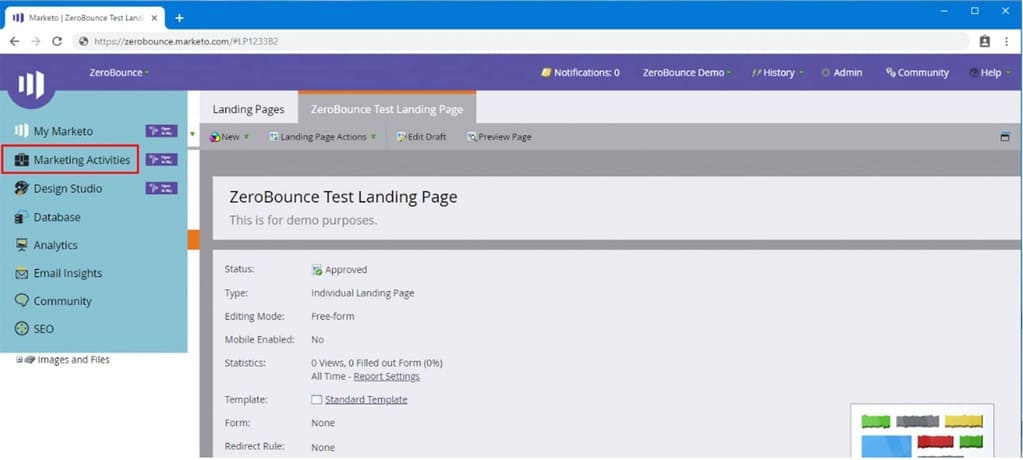
“Select Marketing Activities“ on the left pane
- Step 2:Click on New ➔ New Smart Campaign.

Select "New Smart Campaign"
- Step 3:Fill in the New Smart Campaign form and click Create.
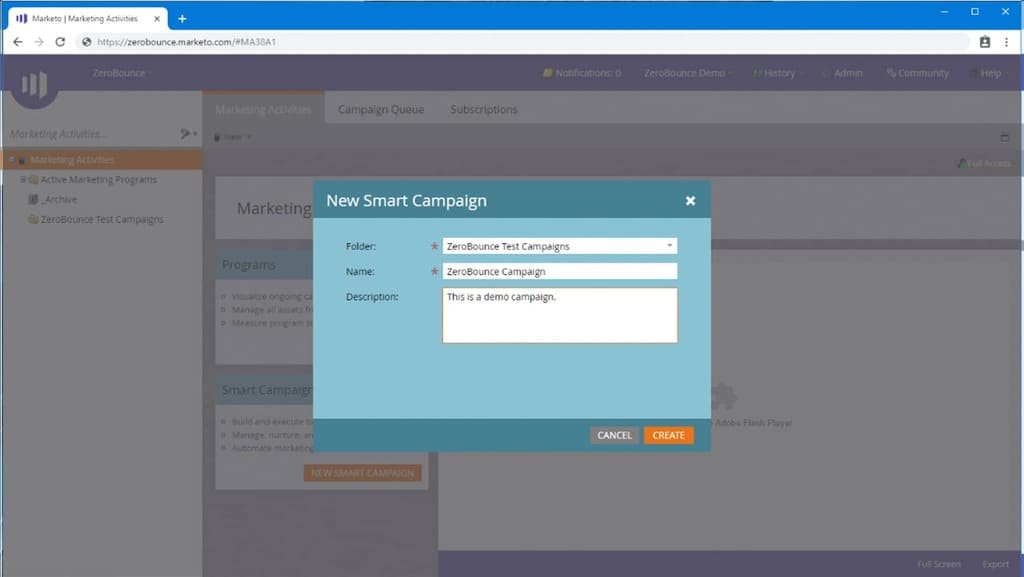
New Smart Campaign form
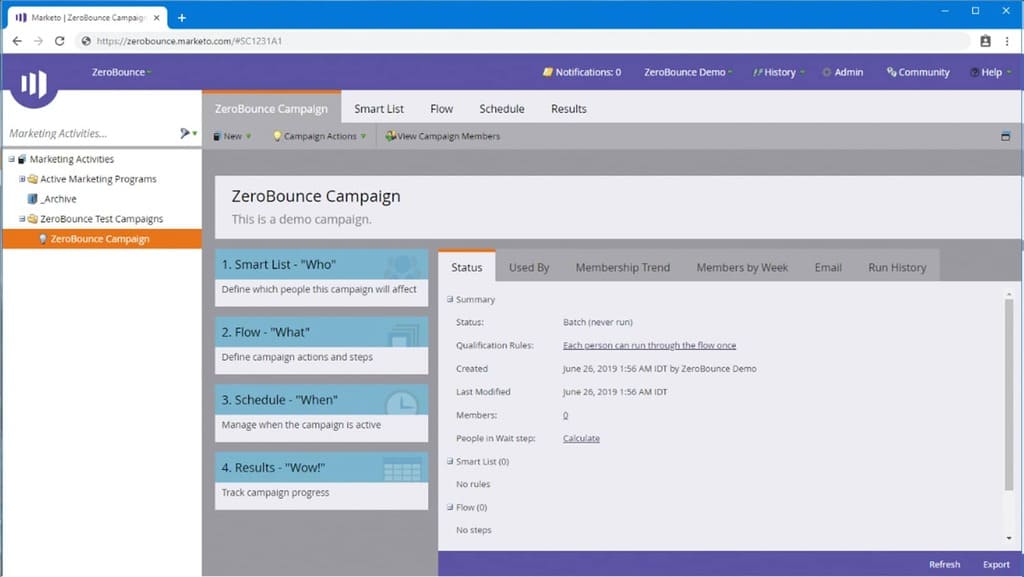
Newly created smart campaign
- Step 4:Click on Smart List in the top navigation for our campaign. Click and drag Fills Out Form over to the editors box.
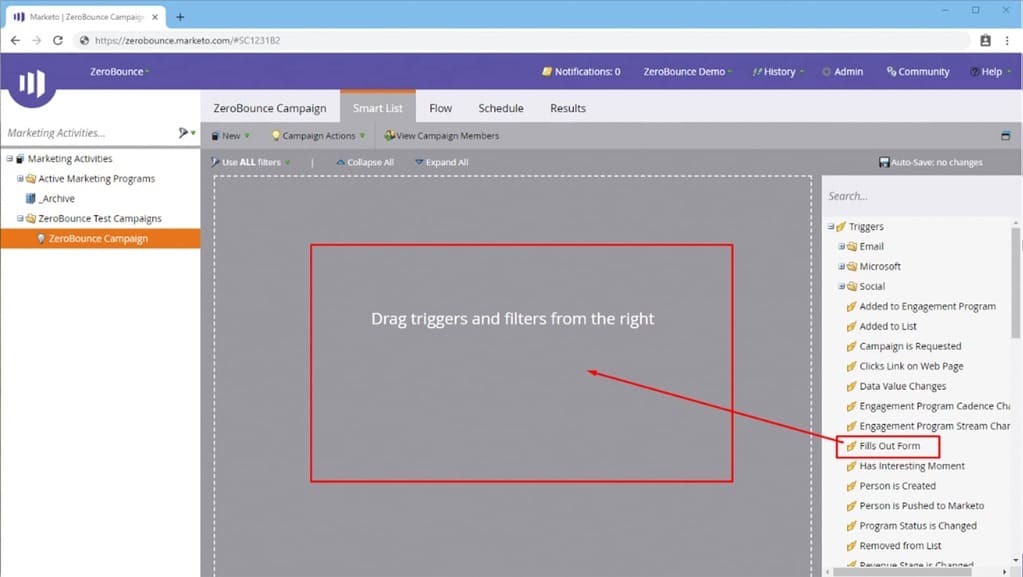
Select "Smart List" on the top navigation next to your Campaign name and then select "Fills Out Form" in the right pane
- Step 5:Fill in the information to use our new ZeroBounce Test Form we created earlier.
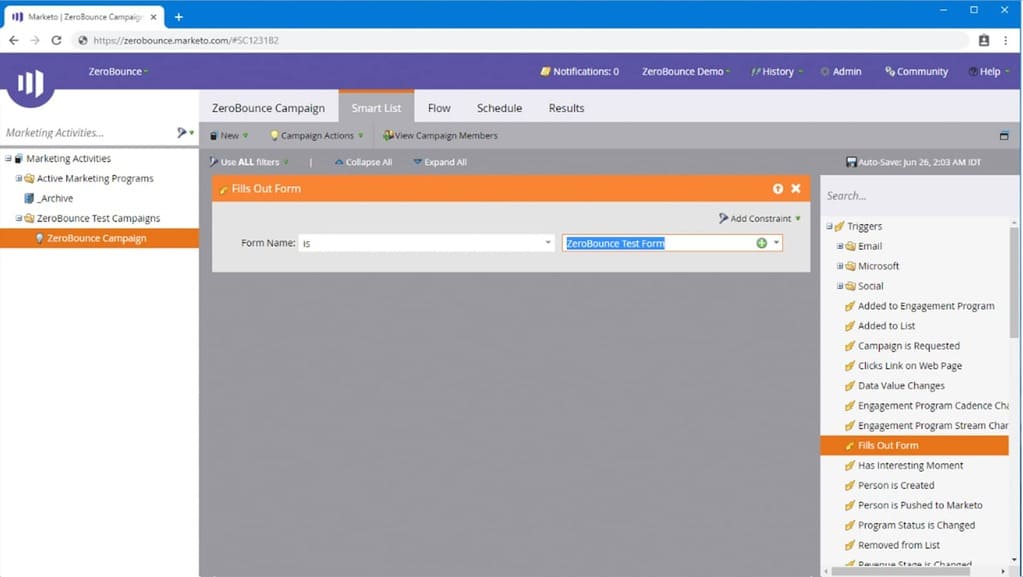
“Smart List > Fill Out Form“ screen
- Step 6:Click on Flow as the next step in the top navigation and select "Call WebHook" on the right pane.
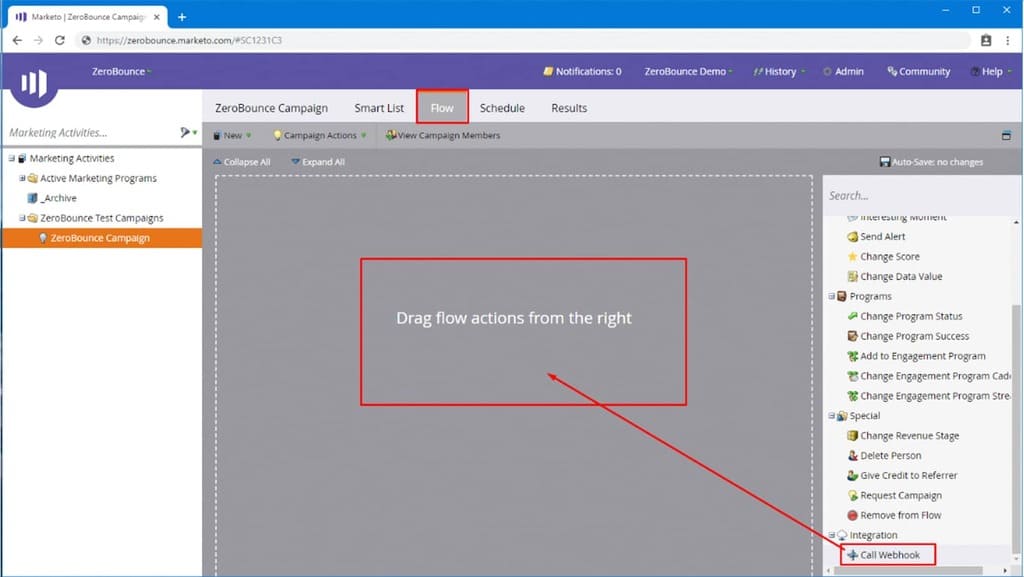
Select "Flow" on the top campaign‘s top nav
- Step 7:Fill in the webhook information for the webhook we created earlier.
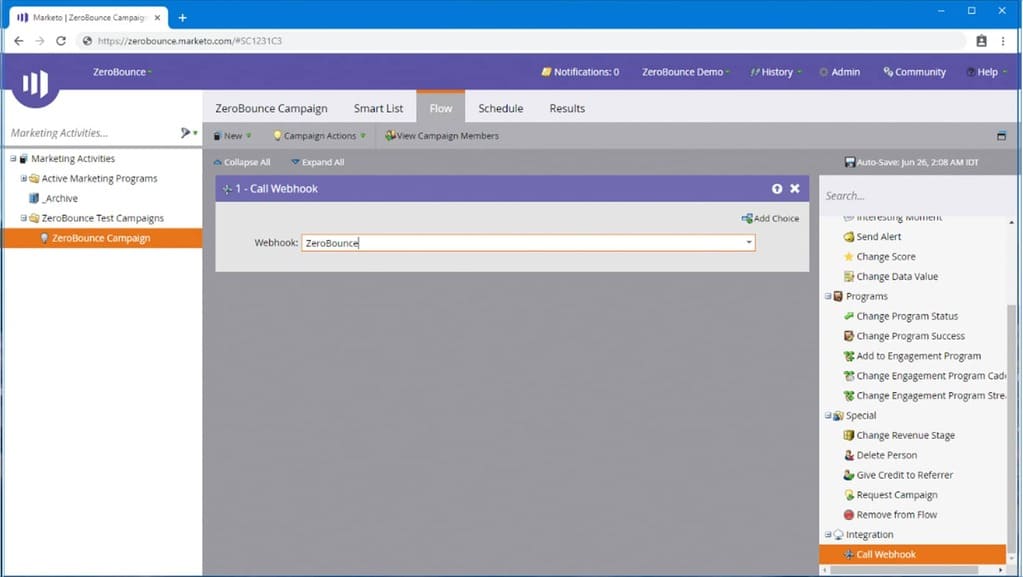
Call WebHook form
- Step 8:Next, click and drag the Add to List to the Flow editor.
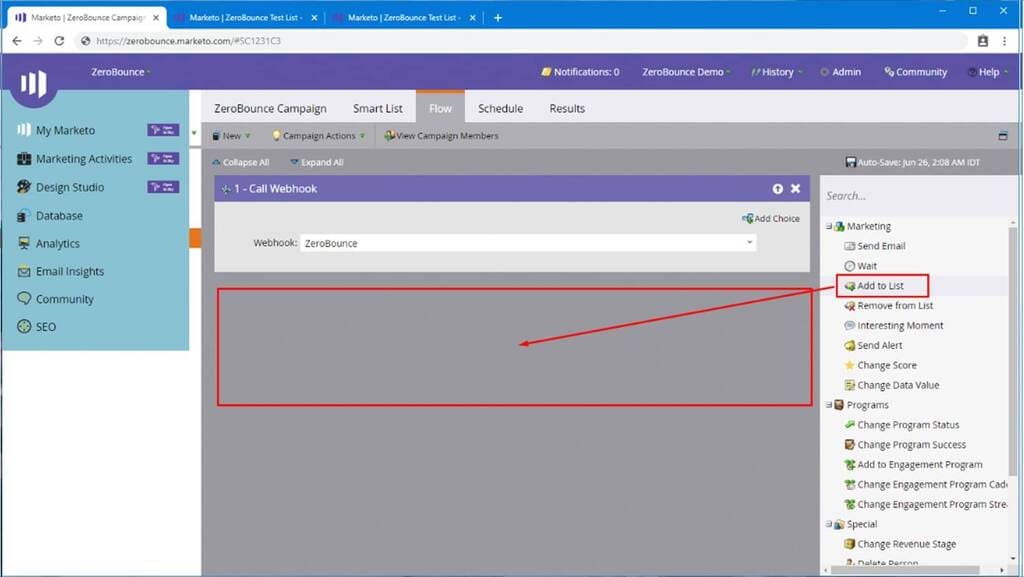
Drag "Add to List" from the right pane to the main window below the "Call WebHook" flow you created
- Step 9:Fill in the information so that we are using the ZeroBounce Test List we created earlier.
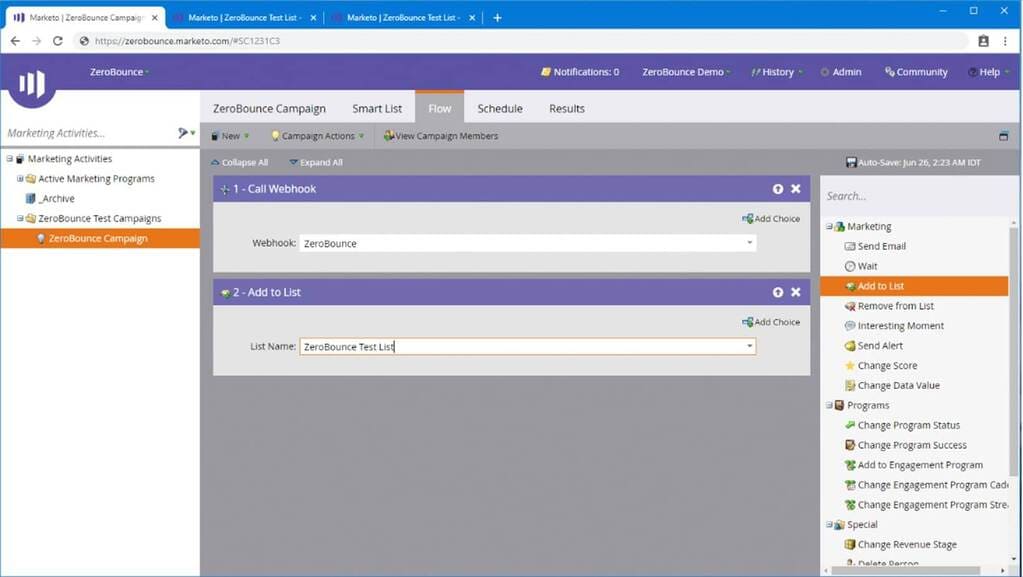
Fill "List Name" with our previously created list
- Step 10:It’s now time to test your webhook.
SETUP COMPLETE
You can now test your webhook by activating the Landing Page you created earlier.